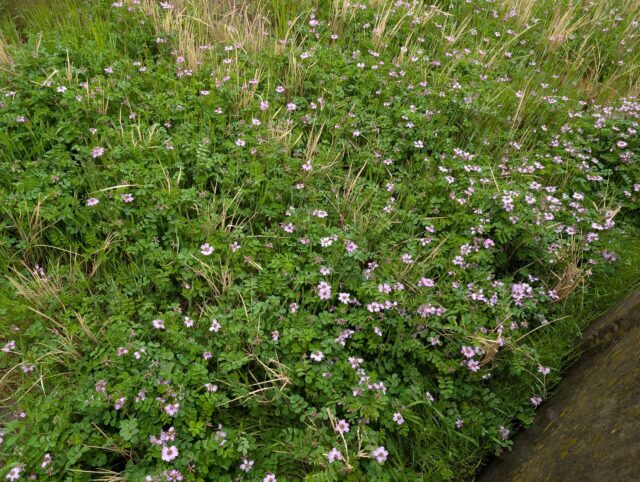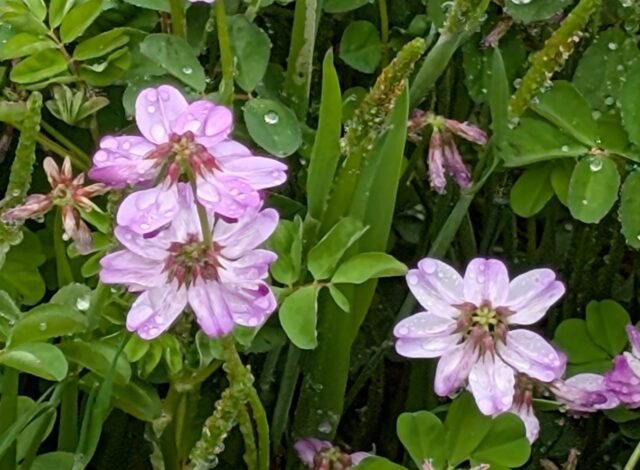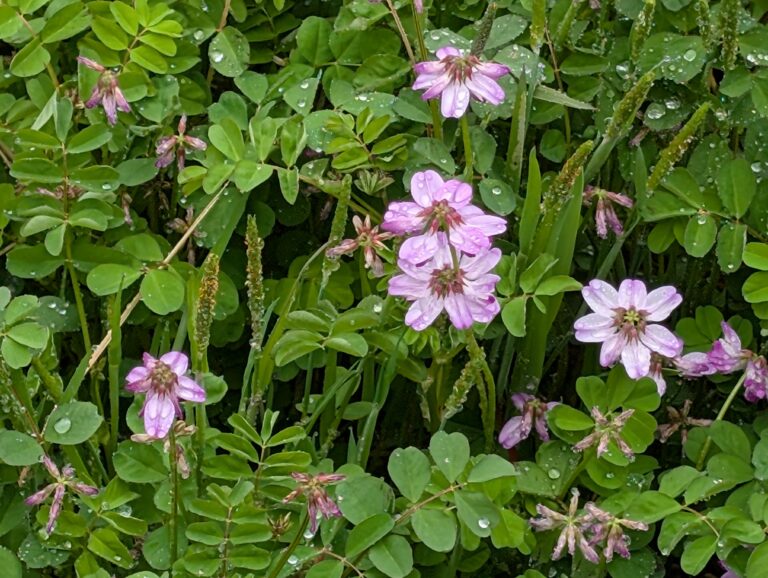When spring arrives in Japan, something magical happens in the countryside. Between April and May, vast fields of delicate purple flowers transform the landscape into a sea of color. These aren’t decorative flower gardens planted for tourists—they’re actually a special type of plant called Chinese Milk Vetch (Renge/蓮華草 in Japanese), growing in what will soon become rice paddies!
This beautiful plant has played a crucial role in traditional Japanese rice farming for centuries. Not only does it create breathtaking scenery that photographers love, but it also serves an essential purpose as natural fertilizer for rice cultivation. It’s a perfect example of how Japanese agriculture has harmoniously blended functionality with beauty.
However, these purple fields are becoming increasingly rare in modern Japan. As a flower enthusiast sharing Japanese botanical wonders with the world, I’m excited to introduce you to this special plant that represents an important aspect of Japan’s agricultural heritage and natural beauty.
What is Chinese Milk Vetch?

Chinese Milk Vetch (Astragalus sinicus) is a leguminous plant native to East Asia. In Japan, it’s commonly known as “Renge” (レンゲ) or more formally as “Genge-so” (蓮華草). Despite its name suggesting Chinese origins, this plant has been deeply integrated into Japanese agricultural traditions for centuries.
The plant itself is quite humble in appearance until it blooms. It grows low to the ground with small compound leaves, but when flowering season arrives, it produces clusters of vibrant purple-pink blossoms that create a stunning visual impact when growing en masse. Each flower has a distinctive shape that resembles a small butterfly or boat, with a structure typical of legumes.
What makes Renge truly special is what happens beneath the soil. Like other legumes, Milk Vetch has the remarkable ability to fix nitrogen from the atmosphere through a symbiotic relationship with bacteria in its root nodules. This natural process enriches the soil with nitrogen, an essential nutrient for plant growth.
Historical Significance in Japanese Agriculture
Renge wasn’t just appreciated for its beauty—it played a vital practical role in the Japanese agricultural system. Historical records show that Japanese farmers have been deliberately cultivating Milk Vetch as green manure (a plant grown specifically to be plowed back into the soil as fertilizer) since at least the Edo period (1603-1868).
During winter when rice fields were fallow, farmers would sow Renge seeds. By spring, the fields would be covered with the flowering plants, which were then plowed under before the rice planting season. This practice:
- Provided natural fertilizer for rice crops
- Prevented soil erosion during winter
- Added organic matter to improve soil structure
- Suppressed weed growth
- Created beautiful landscapes as a bonus
Before the widespread availability of chemical fertilizers in the 20th century, this natural fertilization system was essential for sustainable rice production in Japan.
The Beautiful Relationship Between Rice Paddies and Renge
The partnership between rice paddies and Renge represents one of the most elegant examples of traditional sustainable agriculture in Japan. This relationship benefited both the farmers and the environment in multiple ways.
Role as Green Manure
The primary function of Renge in rice paddies was as green manure—plants grown specifically to be incorporated into the soil while still green to improve soil fertility. When Renge plants are plowed under before rice planting, they provide numerous benefits:
- Natural nitrogen fertilization: As a legume, Renge can fix atmospheric nitrogen through root nodules containing special bacteria. When incorporated into the soil, this organic nitrogen becomes available to rice plants.
- Organic matter addition: The plant material improves soil structure, water retention, and long-term fertility.
- Slow release of nutrients: Unlike chemical fertilizers that can be quickly washed away, nutrients from decomposing Renge are released gradually throughout the growing season.
Before modern fertilizers became widely available, this natural system was the backbone of sustainable rice production in Japan. A healthy stand of Renge could provide approximately 20-30kg of nitrogen per hectare—a significant contribution to rice nutrition.
Contribution to the Ecosystem
Beyond serving as fertilizer, Renge fields create diverse microcosystems that support a variety of wildlife:
- Honeybees and other pollinators thrive on the nectar-rich flowers
- Beneficial insects find habitat among the plants, helping with natural pest control
- Soil microorganisms flourish with the added organic matter, creating healthier soil ecology
- Birds visit the fields to feed on insects and seeds
This biodiversity strengthens the agricultural ecosystem and creates a more balanced environment that requires fewer interventions like pesticides or herbicides.
Beauty of Rural Landscapes
Perhaps the most immediately striking aspect of Renge fields is their extraordinary beauty. During late April to early May, when the plants are in full bloom, they transform ordinary rice paddies into spectacular purple carpets stretching across the countryside.
This seasonal display has become an important cultural touchstone in Japan. The flowering Renge fields represent:
- The arrival of spring after winter
- The cyclical nature of agriculture
- The harmonious relationship between humans and nature
Many Japanese people have childhood memories of playing in or around Renge fields, and the flowers often appear in art, literature, and poetry as symbols of rural beauty and the arrival of spring.
How to Create Renge Fields

If you’re inspired to create your own Renge field—whether for agricultural benefits, to enjoy their beauty, or both—here’s a practical guide to getting started.
Timing and Method for Sowing Seeds
The timing of sowing Renge seeds is crucial for success:
| Season | Activity | Details |
|---|---|---|
| Fall (October-November) | Seed sowing | The ideal time for most regions in Japan |
| Winter | Growth period | Seeds germinate and develop slowly during cooler months |
| Spring (April-May) | Flowering | Beautiful purple blooms appear |
| Late Spring | Incorporation | Plants are plowed into soil before rice planting |
The traditional method for sowing Renge seeds follows these steps:
- Prepare the field: After harvesting rice in autumn, lightly till the soil surface to create a suitable seedbed.
- Sow the seeds: Broadcast the seeds evenly across the field at a rate of approximately 15-20kg per hectare. The seeds are small, so mixing them with some sand can help achieve even distribution.
- Cover lightly: A thin layer of soil (about 1cm) over the seeds is ideal. Too deep, and germination will be poor.
- Water management: While Renge doesn’t need standing water like rice, ensure the soil remains moist during germination.
Optimal Conditions and Cultivation
Renge is relatively easy to grow under the right conditions:
- Soil pH: Slightly acidic to neutral (pH 5.5-7.0) is ideal
- Sunlight: Full sun is best for vigorous growth
- Water: Moderate moisture; can tolerate some flooding but not extended periods
- Climate: Temperate conditions with mild winters are perfect
The beauty of Renge is that it requires minimal maintenance once established. It grows naturally during winter and early spring when most farmers have less fieldwork to do. This ease of cultivation was one of the main reasons it became popular in traditional Japanese agriculture.
Dealing with Continuous Cropping Issues
While Renge is generally beneficial for soil, continuous cultivation can sometimes lead to issues:
- Pest buildup: Some insects or diseases can become problematic if Renge is grown repeatedly
- Soil imbalances: Excessive nitrogen can develop in some cases
- Self-inhibition: Like many plants, Renge can sometimes release compounds that inhibit its own growth when planted repeatedly
To prevent these potential problems:
- Rotate with other cover crops: Consider alternating Renge with other green manures like clover or hairy vetch
- Monitor soil health: Regular soil tests can help identify any developing imbalances
- Adjust sowing rates: Reduce seed density if self-inhibition seems to be occurring
- Mix seed varieties: Combining different cultivars can increase resilience
Renge as Fertilizer for Rice Paddies
The relationship between Renge and rice cultivation goes beyond just adding a splash of color to the countryside—it’s a sophisticated natural fertilization system that has supported Japanese agriculture for centuries.
Nitrogen Fixation Mechanism
The magic of Renge lies in its ability to capture nitrogen from the air and convert it into forms plants can use—a process called biological nitrogen fixation. Here’s how it works:
- Renge forms a symbiotic relationship with soil bacteria called Rhizobium
- These bacteria live in small nodules on the plant’s roots
- Inside these nodules, bacteria convert atmospheric nitrogen (N₂) into ammonia (NH₃)
- This nitrogen gets incorporated into amino acids and proteins within the plant
- When the plant is turned into the soil, these nitrogen compounds become available to the next crop
This natural process is remarkably efficient and environmentally friendly. A healthy stand of Renge can provide between 100-200 kg of organic matter per 10 ares (0.1 hectare), containing valuable nitrogen, phosphorus, and potassium.
Soil Improvement Effects
Beyond just adding nitrogen, incorporating Renge into soil delivers multiple benefits:
- Improves soil structure: The plant material helps create better soil aggregation and porosity
- Increases organic matter: This enhances the soil’s ability to hold water and nutrients
- Enhances microbial activity: The additional organic matter feeds beneficial soil organisms
- Prevents erosion: Renge’s root system helps hold soil in place during winter
- Suppresses weeds: Dense Renge growth naturally reduces weed pressure
These improvements create healthier soil that becomes more productive over time, rather than being depleted by continuous cropping.
Comparison with Chemical Fertilizers
How does Renge stack up against modern chemical fertilizers? Here’s a comparison:
| Aspect | Renge as Green Manure | Chemical Fertilizers |
|---|---|---|
| Nitrogen supply | Moderate, slow-release | High, immediate |
| Environmental impact | Minimal, enhances ecosystem | Can cause runoff and pollution |
| Cost | Seed cost only (inexpensive) | Recurring expense |
| Additional benefits | Soil structure, erosion control, biodiversity | None beyond nutrition |
| Long-term soil health | Improves over time | May decline with exclusive use |
| Labor | Seasonal (seeding, incorporation) | Less (application only) |
Many modern farmers in Japan are rediscovering the value of combining traditional methods like Renge cultivation with selective use of modern inputs—getting the best of both worlds while reducing environmental impact.
Why Renge Fields are Disappearing
Despite their beauty and benefits, Renge fields have been steadily disappearing from the Japanese countryside over the past several decades. This decline represents a significant shift in agricultural practices and rural culture.
Impact of Agricultural Modernization
The primary factor behind the disappearance of Renge fields has been the modernization and industrialization of Japanese agriculture since the mid-20th century:
- Chemical fertilizers became widely available, offering immediate nutrient delivery without waiting for green manure to decompose
- Mechanization of farming made traditional practices seem time-consuming in comparison
- High-yield rice varieties were developed that responded well to chemical inputs
- Labor shortages in rural areas as young people moved to cities made efficiency necessary
As farmers sought to maximize efficiency and minimize labor, many traditional practices—including Renge cultivation—were gradually abandoned in favor of more modern approaches.
Economic Factors
Economic pressures have also played a significant role in the decline:
- Cost competition from imported rice pushed farmers to cut costs and increase yields
- Aging farmer population without successors led to abandonment of many rice paddies altogether
- Land use changes converted many former agricultural areas to residential or commercial use
- Government policies sometimes favored modernization over traditional methods
The economics of modern agriculture often made it difficult to justify the time and effort of maintaining traditional practices like Renge cultivation, despite their environmental benefits.
Environmental Impact
The disappearance of Renge fields has had several negative consequences:
- Reduced biodiversity: The loss of flowering fields has impacted pollinators and other wildlife
- Increased chemical dependence: More chemical fertilizers are needed without green manure
- Soil degradation: Reduced organic matter inputs affect long-term soil health
- Cultural heritage loss: A beautiful aspect of Japan’s agricultural landscape is vanishing
- Water quality issues: Chemical fertilizer runoff can cause water pollution
These changes represent not just an aesthetic loss but also a shift away from sustainable agricultural practices that had evolved over centuries to work in harmony with local ecosystems.
Revival of Renge Fields: For Sustainable Agriculture
Despite the decline, there are encouraging signs of renewed interest in Renge cultivation across Japan, driven by both environmental concerns and cultural preservation efforts.
Success Stories
Several regions have launched successful initiatives to restore Renge fields:
- Oda region in Tsukuba has preserved beautiful Renge fields that attract visitors and photographers each spring
- Organic rice farmers in Kyushu have reintroduced Renge as part of sustainable farming systems
- Community projects in Niigata Prefecture have restored Renge fields as both agricultural assets and tourist attractions
- Research farms at agricultural universities are studying and demonstrating the benefits of traditional green manure systems
These success stories demonstrate that traditional practices can be successfully integrated with modern farming approaches to create sustainable, productive, and beautiful agricultural landscapes.
Contribution to Local Revitalization
Beyond their agricultural value, Renge fields are increasingly recognized for their potential to contribute to rural revitalization:
- Agritourism opportunities: Flowering Renge fields attract visitors, photographers, and nature lovers
- Cultural education: Traditional farming practices can be showcased to younger generations
- Local identity and pride: Distinctive landscapes help communities maintain their unique character
- Value-added products: Honey from Renge flowers commands premium prices
- Environmental credentials: Sustainable practices can help market agricultural products
In some areas, local governments and tourism associations are actively promoting Renge fields as seasonal attractions, creating new economic opportunities in rural communities.
Tourism Potential
The spectacular visual impact of flowering Renge fields offers significant tourism potential:
- Photography enthusiasts seek out these purple landscapes for stunning nature shots
- Cultural tourists interested in traditional Japanese rural life and agriculture
- Eco-tourists interested in sustainable farming practices
- Educational groups learning about agricultural heritage and ecology
- Seasonal visitors enjoying spring flowers beyond the famous cherry blossoms
As interest in experiential and sustainable tourism grows, Renge fields offer a unique attraction that connects visitors with both natural beauty and agricultural heritage.
Conclusion
Chinese Milk Vetch (Renge) represents a perfect harmony between practical agriculture and natural beauty that has characterized Japanese farming traditions for centuries. These purple flowers that once carpeted rice paddies across Japan served as both an effective natural fertilizer system and a breathtaking seasonal display that marked the arrival of spring.
The Future of Renge
While traditional Renge cultivation has declined dramatically with agricultural modernization, there are promising signs of revival. As concerns about sustainable agriculture grow, more farmers are reconsidering the wisdom of traditional practices like green manuring with Renge. Meanwhile, the aesthetic and cultural value of these purple fields is being rediscovered by new generations seeking connection with nature and agricultural heritage.
The future of Renge in Japan likely lies in finding a balance—incorporating this traditional plant into modern agricultural systems where appropriate, while also preserving and restoring Renge fields as living cultural landscapes that can be enjoyed by both locals and visitors.
Lessons from Traditional Japanese Farming
The story of Renge offers important lessons for contemporary agriculture worldwide:
- Working with nature often provides more sustainable solutions than working against it
- Beauty and utility don’t have to be separated—agricultural landscapes can be both productive and aesthetically pleasing
- Traditional knowledge often contains sophisticated understanding of local ecosystems developed over generations
- Cultural and environmental values can be preserved alongside agricultural productivity
In a world facing serious environmental challenges, these lessons from traditional Japanese rice farming with Renge deserve renewed attention and appreciation.
Message to Readers
If you visit Japan in late April or early May, venture beyond the cities and famous tourist sites to look for the increasingly rare purple carpets of Renge in the countryside. These beautiful fields represent not just a visual treat but a glimpse into the sustainable agricultural traditions that have shaped the Japanese landscape for centuries.
For gardeners and small-scale growers worldwide, consider experimenting with Chinese Milk Vetch as a cover crop or green manure in your own growing spaces. Its nitrogen-fixing capabilities, soil-improving qualities, and beautiful flowers make it a valuable addition to sustainable growing systems—and a small way to connect with this beautiful aspect of Japanese agricultural heritage.
By appreciating and preserving traditional practices like Renge cultivation, we honor both cultural wisdom and ecological harmony—values that have never been more important than they are today.

